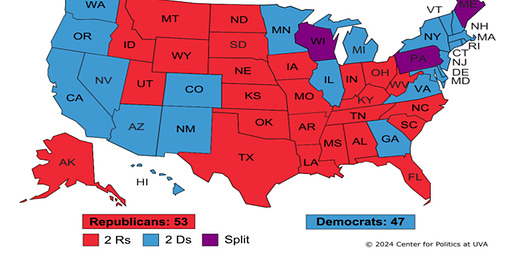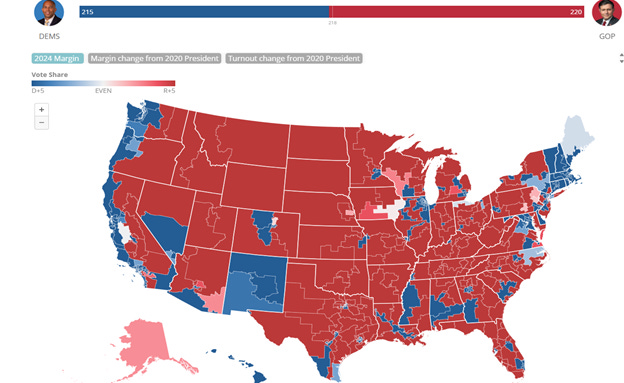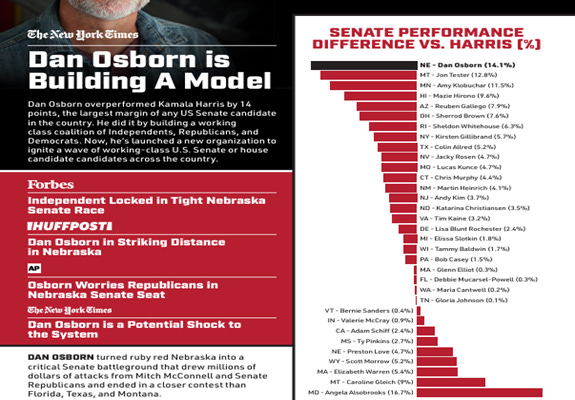Democrats Won’t Win the Senate in 2026 by Themselves
Look West for Fresh Approaches to Expanding the Blue Map
It’s a sorry state of affairs for the Democratic Party that for all the corruption, lawlessness, declining growth and higher prices, and resulting low approval ratings of the Trump administration, many pundits doubt the Dems will take back the US Senate in the 2026 midterms. The House, yes. But not the Senate. That speaks to bumbling party leadership. But also a damaged brand and the resulting ugly electoral math. The Republicans currently have a 53 seat majority in the US Senate. Of the 22 Republicans seeking reelection in 18 months (including the two special elections for seats vacated by Rubio and Vance), only 2 seats are widely considered vulnerable: North Carolina and Maine. Democrats, on the other hand, face the retirement of 4 incumbents (Baldwin in Minnesota, Sheehan in New Hampshire, Durbin in Illinois and Peters in Michigan) and a tough race for Dem Senator John Ossoff in Georgia. Even if Democrats win all of these races (including Maine and North Carolina), they’ll still be two short of a majority.
This isn’t a one-time challenge for Dems. It’s a structural one. Democrats are not competitive in large swaths of the country. They lack Congressional seats and are semi-permanent minorities in a number of state legislatures and governors’ offices. The maps below highlights the problem regarding the Blue “desert” of elected federal office holders in rural western states (as well as some southern ones):
Current US Senate
The situation looks worse when you look at the House map where in many of the rural states there are no pockets of Blue. In Utah, Idaho, Wyoming, North Dakota and South Dakota, for example, Republican House incumbents won their 2024 elections by 30% + margins.
Current US House
It's true that some of the Red in purple states like North Carolina and Wisconsin is due to Republican gerrymandering that has disadvantaged Democrats running for state legislative and US House seats. North Carolina, for example, is a decidedly purple state that has a Democratic Governor, Lt Governor and AG but disproportionate Republican majorities in the legislature and the Congressional delegation owing to partisan-drawn voting districts.
But in the solid Red rural states, Democrats are not competitive. There are exceptions, of course. Monica Tranel lost to Montana Republican incumbent Ryan “stinky” Zinke in Montana’s less conservative western House district by 7% (not great, but not double digits, and a better margin than Harris vs. Trump in the state). In general, however, Democrats have effectively ceded large swaths of the electoral map to Republicans.
Democrats lack of competitiveness in these rural areas creates a number of problems:
1) Dems face possible multi-cycle minority status in the US Senate;
2) Their hopes of attaining a slim Senate majority is consigned to a narrow number of very expensive swing states;
3) This imbalance provides Republicans inexpensive “safe” seats that allow them to train their campaign firepower on toss-up races.
There are numerous sports analogies, but think of a baseball game in which each time the Democrats come to bat, the foul lines are shifted “in,” narrowing the field, but when the Republicans come to bat, the foul lines are moved back, widening the field. Democrats still might win, but it’s an uphill battle.
Clearly, Democrats need to reconnect with working class and rural voters. And a fresh, charismatic leader in 2028 could help reset perceptions of the party. But Dems aren’t going to strike lightening in time for 2026. To win the Senate in 2026 will require new tactics that can expand the electoral map in Red states. Fortunately, some promising work is being done in this regard and the successes are starting to garner notice.
Expanding the Blue electoral map
Some impressive initiatives to build cross-partisan coalitions that promote Blue-oriented policies have produced results – most notably Alaska but also in places like Montana. The Rural West Project (RWP) has been active in a number of rural western states and pursues a bottom-up process of backing proven local operatives who establish operations that push locally-driven strategies full-time, year-round.
The results in Alaska are particularly impressive and the product of comprehensive long-term efforts by RWP and 907 Initiative (here ) to identify key issues and vulnerabilities of Republican incumbents, frame the narratives around local and state-wide issues early on, recruit solid candidates and run campaigns steered by locals (not K St. consultants flown in 6 months before an election). The proof is in the pudding: the statehouse has flipped from large Republican majorities in both state chambers in 2012 to Blue coalition majorities today comprising Independents, Democrats and moderate Republicans. Independents have played an outsized role -- there were 5 independent candidates in 2012 vs 38 in 2022.
In Montana, a caucus of 9 non-MAGA Republicans has helped stymie the worst of MAGA impulses and voted with Dems to reauthorize Medicaid expansion and fund maternal health care, for example, as well as block bills that would have weakened labor unions and make state courts more partisan. Dubbed the ‘Nasty Nine” by their hard-right MAGA colleagues, these Republicans are demonstrating an independent streak characteristic of the state’s political history. The success of their more centrist approach could boost the competitiveness and prospects of Independents (and centrist Democrats), which in turn could lead to a more dependable centrist coalition.
While these efforts have turned statehouse politics either blue or “magenta,” they also provide more fertile soil for Independent or Democratic candidates to run for federal offices. In Alaska, Democrat Mary Peltola successfully ran for the state’s only House seat in 2022. She is reportedly considering running for either Governor or US Senate in 2026.
The more recent political shocker was the outperformance of Independent Dan Osborn in his 2024 Nebraska Senate race against Republican incumbent Deb Fischer. Osborn came out of nowhere and while he lost, he spooked the Republican/MAGA establishment and outperformed the Harris’ margin vs Trump in his state by more than any Democrat Senate candidate in 2024.
Osborn is a Navy veteran, industrial mechanic and union leader. He was recruited in 2023 to run by Daniel Moraff, a young but experienced political/campaign strategist. Osborn had no prior political experience. He ran as an independent so that he wouldn’t be burdened with the baggage of the Democratic party in deep red Nebraska. Despite lacking the infrastructure and financial support of a mainstream party, Osborn’s messaging around his “paycheck populism” platform resonated. He generated grass roots enthusiasm, received early support from RWP, became a viral sensation, moved-up to parity in the polls, garnered national attention and then, belatedly, saw significant donor support. He also scared Republicans into pouring millions into a Senate race they’d considered a safe seat. Osborn is now poised to parlay his experience and recognition to run again in 2026, this time against NE’s other senator, billionaire Pete Ricketts, a trust fund baby and son of Joe Ricketts, who founded TD America and bought the Chicago Cubs in 2009. Osborn recently started a PAC, Working Class Heroes Fund (here), that is identifying working class candidates in red states and districts to run for state and federal office.
Independent candidates are a key part of expanding the Blue Senate map
There are 3 Red states where incumbent Republican Senators are expected to be more vulnerable in 2026 than conventional wisdom might suggest:
Nebraska: Where the bland trust-fund baby, Ricketts, may not play well – especially if he’s forced to defend his support for Trump budget cuts to Medicaid and food programs to help pay for tax cuts to rich billionaires like himself. Dan Osborn’s working class roots and focus on kitchen table issues provide a nice contrast.
Alaska: Where the remote Dan Sullivan is getting hammered by groups like the 907 Initiative for being AWOL from the state and supporting Trump policies that hit Alaska particularly hard (e.g., lay-offs of federal workers, tariffs that hurt more than they help, lost government funding).
Iowa: Where Senator Joni Ernst was faring poorly even before her “we are all going to die” response at a Town Hall meeting where constituents were complaining about cuts to Medicaid and SNAP programs.
It looks like Iowa Democrats will have a full slate of primary candidates seeking the nomination in the party primary next year. In Nebraska, Dan Osborn is running as an Independent and it seems unlikely a credible Democrat will run as a spoiler. Alaska’s Senate race is waiting for Mary Peltola to decide whether she’ll run for US Senate or Governor. If she chooses the latter, the main opposition candidate to Sullivan could well be an Independent.
An Independent candidate could be difference maker in one and maybe two of the Red state US Senate elections that are needed to break the Republican majority.
Remember too that an Independent candidate could emerge in another Red state unexpectedly (as happened with Osborne) and give an incumbent a run for their money.
Why Democratic donors should back these efforts to support “strange bedfellow” coalitions and Independents:
1) It’s a proven winning approach. Also, it’s a relatively low cost, high return use of donor funds. These are low population states where early and effective groundwork can pay big dividends.
2) None of these groups or candidates are seeking to establish a new party or compete with Democrats. Osborn decided against a 2026 run versus Congressman Don Bacon (who has since announced that he’ll retire) in NE 2 (which has blue-voting Omaha) when it became apparent that the Dems would field their own candidate.
3) These independent candidates and groups are pushing Blue-oriented policies in Red districts and states (mainly rural) where Dems are not competitive. They’d like Dems to fix their brand with these voters but aren’t waiting for that to happen.
Cross-partisan coalitions that make Blue values competitive are a good investment
The current Democratic model for winning the Senate is very expensive with limited avenues to success. Conversely, the efforts by RWP and aligned groups to expand the Blue map offer relatively a low cost and coherent, proven formula for winning. RWP is playing the long game and establishing a local infrastructure for sustainable progress over time. Think of the contrast in approaches and where an incremental donation might go furthest:
· Democrats have largely conceded the rural states. That leaves them having to spend huge sums in swing states. If a surprisingly talented and effective candidate did emerge in a rural Red state, Dems might provide some late support, flying in DC-based campaign consultants to make expensive ad buys 3-6 months before an election.
· RWP is using experienced local political professionals now to identify key local issues, engage in opposition research and messaging, frame narratives in on-line and legacy media, recruit solid candidates for local, state and federal offices, and run cost-effective campaigns. The track record is better and faster in some places than others, but there’s demonstrable progress (even in states like Utah and Wyoming).
The efforts in these rural states and districts are relatively inexpensive. If you think about political donations as investments (which they are in many respects), early donations to groups in these markets offer a potential huge return. Yes, there will be losses. And progress could be slow in some states. But if we see two Independent candidates flip the US Senate to a Blue majority, it will be likely be the cheapest and highest return on most donors’ history of giving.
To learn more about these groups (and to donate) see the links below:
Dan Osborn for Senate (here)
Working Class Heroes Fund (here)
907 Initiative (here)
Rural West Project:
Donations to RWP’s “Way Back PAC” are considered most helpful.
Independent Candidate Initiative (don’t have a link at this time)
There are likely other groups doing work in this space, but these are groups (and a candidate) with whom I’ve met that seem credible to me and various giving circles and political fundraising groups.





